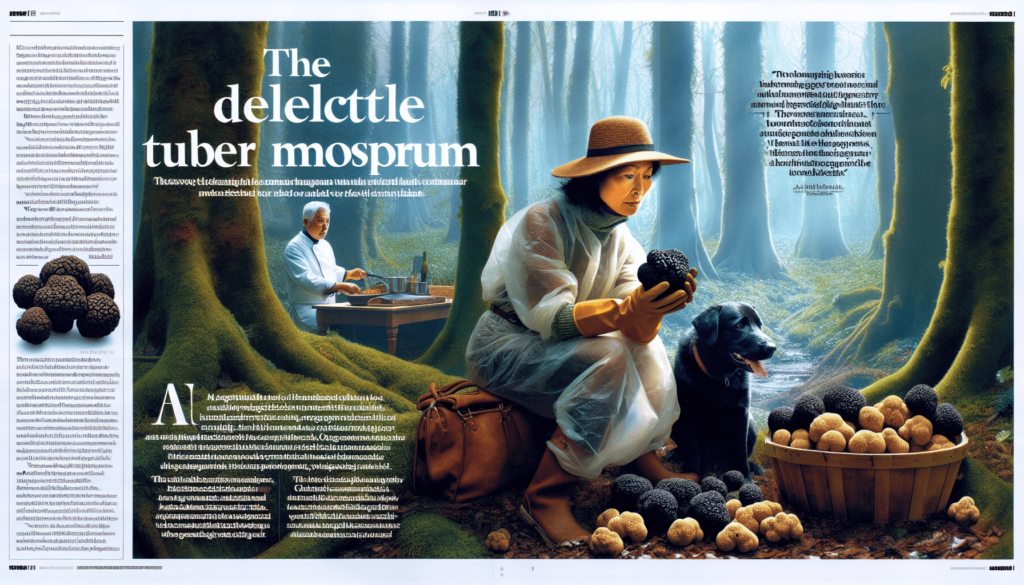Imagine indulging in the enchanting aroma and delicate flavor of the exquisite Tuber Melanosporum. Commonly known as the black truffle, this delectable tuber is a culinary treasure that has captured the hearts and palates of food connoisseurs across the globe. Its mesmerizing qualities, paired with its elusiveness and scarcity, have elevated the black truffle to a sought-after delicacy that adds a touch of sophistication and luxury to any dish. Join us on a journey to explore the captivating world of the Tuber Melanosporum and discover why it is hailed as the crowned jewel of the culinary world.

What is Tuber Melanosporum?
Tuber Melanosporum, commonly known as black truffle, is a highly sought-after culinary delicacy that originates from various regions around the world. This prized truffle species belongs to the Ascomycota phylum and is characterized by its black exterior with a rough, warty texture, which encases a fragrant, earthy, and intense flavor.
The origins of Tuber Melanosporum
Tuber Melanosporum has a rich history dating back centuries. It is believed to have originated in the Mediterranean region, particularly in Southern Europe and Northern Africa. The truffle’s popularity soon spread to other parts of the world, including Italy, France, Spain, and even parts of Asia.
The characteristics of Tuber Melanosporum
Tuber Melanosporum possesses distinctive characteristics that contribute to its unparalleled culinary reputation. These truffles typically have a round or irregular shape, with a dark brown to black exterior that is covered in small pyramidal warts. Underneath the surface, the flesh is dark brown to black, marbled, and marked by a complex network of veins.
One of the most striking features of Tuber Melanosporum is its aroma. When mature, this truffle emits a powerful scent that has been described as musky, woody, and reminiscent of damp earth. The intense aroma of Tuber Melanosporum contributes significantly to its desirability in the culinary world.
The culinary significance of Tuber Melanosporum
Tuber Melanosporum is highly regarded for its exceptional gastronomic qualities, making it a prized ingredient in various cuisines across the globe. Its unique flavor profile adds depth and complexity to dishes, elevating them to new culinary heights.
Chefs and gourmands alike value Tuber Melanosporum for its earthy and nutty flavor with hints of chocolate and garlic. This versatile truffle is used to enhance the taste of a wide range of dishes, including pasta, risottos, eggs, meats, and even desserts. Its ability to bring out the best in other ingredients and create a symphony of flavors makes Tuber Melanosporum truly exceptional.
Harvesting Tuber Melanosporum
The ideal climate for growing Tuber Melanosporum
Tuber Melanosporum thrives in a specific climate, which contributes to its successful cultivation. This truffle species prefers a temperate climate with mild winters and moderate rainfall. The ideal temperature range for its growth is between 11°C and 25°C (52°F and 77°F), and it requires well-drained soils with good aeration.
Regions such as the Périgord region in France, Alba in Italy, and in parts of Spain, are known to have the perfect climate and soil conditions for cultivating Tuber Melanosporum.
The process of harvesting Tuber Melanosporum
Harvesting Tuber Melanosporum is a meticulous and labor-intensive process that requires skill and knowledge. Traditionally, truffle hunting has relied on the partnership between humans and their canine companions. Truffle hunting dogs, such as Lagotto Romagnolo or trained pigs, are trained to sniff out the truffles buried beneath the soil.
Truffle hunters carefully observe the behavior of their dogs and rely on their exceptional olfactory abilities to locate the truffles. Once a truffle has been located, the truffle hunter gently unearths the truffle using specialized tools, ensuring minimal disruption to the delicate ecosystem surrounding the truffle.
The role of truffle hunting dogs in the harvest
Truffle hunting dogs play a crucial role in the successful harvest of Tuber Melanosporum. These specially trained canines possess a remarkable sense of smell, enabling them to detect the aroma of truffles even when they are buried deep beneath the soil. Their keen instincts and unwavering focus make them indispensable partners in the truffle hunting process.
The bond between truffle hunters and their dogs is unique and built on trust and mutual understanding. The well-being and safety of the dogs are of utmost importance, and truffle hunters take great care to ensure their dogs are well-fed, rested, and treated with respect.
The Culinary Uses of Tuber Melanosporum
Tuber Melanosporum in traditional French cuisine
In traditional French cuisine, Tuber Melanosporum holds a revered place. Its distinct flavor and aroma make it a sought-after ingredient in many classic French dishes. The truffle is often shaved or minced and used as a finishing touch to elevate the taste of various dishes.
One iconic French dish that showcases the exquisite flavor of Tuber Melanosporum is the Périgord Black Truffle Soup. This velvety soup is made with a combination of truffles, broth, cream, and other aromatic ingredients. The result is a luxurious and deeply satisfying dish that exemplifies the unique qualities of Tuber Melanosporum.
Creative applications of Tuber Melanosporum in modern cuisine
In modern cuisine, Tuber Melanosporum has found new and innovative uses that showcase its versatility. Chefs experiment with this treasured ingredient, pushing the boundaries of traditional dishes and creating extraordinary culinary experiences.
One creative application of Tuber Melanosporum is its infusion into oils or vinegars, which imparts its distinct flavor and aroma to food. Truffle-infused oils can be drizzled over pasta, pizzas, or even salads to add a touch of luxury. Additionally, chefs have also discovered the art of combining Tuber Melanosporum with chocolate to create unique truffle-infused desserts that surprise and delight the palate.
Pairing Tuber Melanosporum with other ingredients and dishes
The flavor profile of Tuber Melanosporum makes it a versatile ingredient that pairs beautifully with a wide range of ingredients and dishes. The earthy and intense flavors of this truffle perfectly complement ingredients such as eggs, potatoes, cheeses, and mushrooms.
One classic pairing is Tuber Melanosporum with eggs. Whether incorporated into omelets, scrambled eggs, or as a topping for poached eggs, the truffle elevates the humble egg to a luxurious delight. Another popular combination is Tuber Melanosporum with pasta, where the richness of the truffle enhances the flavors of the pasta, creating a truly memorable dish.
Health Benefits of Tuber Melanosporum
The nutritional profile of Tuber Melanosporum
While Tuber Melanosporum is primarily enjoyed for its culinary qualities, it also offers various health benefits. This truffle species is low in calories and fat, making it a suitable addition to a balanced diet. It is also a good source of fiber, which aids in digestion and helps maintain a healthy gut.
Tuber Melanosporum contains several essential vitamins and minerals, including vitamin C, potassium, and calcium. Vitamin C supports immune function, while potassium helps maintain proper heart and muscle function. Calcium promotes strong bones and teeth.
The potential medicinal properties of Tuber Melanosporum
Research suggests that Tuber Melanosporum may possess certain medicinal properties that contribute to overall well-being. Studies have shown that this truffle species contains antioxidants, which protect cells from damage caused by free radicals. Antioxidants have been linked to reducing the risk of chronic diseases, such as heart disease and certain types of cancer.
Additionally, Tuber Melanosporum is believed to have anti-inflammatory properties, which may help alleviate symptoms associated with inflammatory conditions. It is important to note that further research is needed to fully understand and validate these potential health benefits.
The use of Tuber Melanosporum in alternative medicine
Tuber Melanosporum has also found its way into alternative medicine practices. Some practitioners believe that this truffle has aphrodisiac properties and can enhance libido and sexual performance. However, it is essential to approach such claims with caution and consult with a healthcare professional before incorporating Tuber Melanosporum into any alternative medicinal practices.

Cultivating Tuber Melanosporum
The challenges of cultivating Tuber Melanosporum
Cultivating Tuber Melanosporum is a challenging endeavor that requires patience, expertise, and careful attention to detail. One of the primary challenges lies in replicating the specific environmental conditions that foster the truffle’s growth naturally. The precise combination of temperature, rainfall, and soil composition must be achieved to ensure a successful harvest.
Another challenge is the slow growth rate of Tuber Melanosporum. It can take several years for the truffle to reach maturity, making it a long-term investment for truffle cultivators. Additionally, the truffle’s symbiotic relationship with tree roots, often oaks or hazelnut trees, further complicates the cultivation process.
Methods and techniques for cultivating Tuber Melanosporum
Several methods and techniques have been developed to cultivate Tuber Melanosporum successfully. One prominent technique is known as truffle orcharding. This involves establishing truffle plantations by inoculating the roots of young trees with Tuber Melanosporum spores, creating a symbiotic relationship between the truffle and the tree.
Truffle orcharding requires careful monitoring of soil conditions, irrigation, and pruning to ensure optimal growth. Cultivators must also implement measures to protect the truffle orchards from potential threats such as pests and diseases. Successful cultivation of Tuber Melanosporum requires a harmonious balance between nature and human intervention.
The economic impact of Tuber Melanosporum cultivation
The cultivation and trade of Tuber Melanosporum have significant economic implications for the regions where it is grown. Truffle cultivation provides employment opportunities and boosts the local economy, particularly in rural areas where agriculture is a key industry.
Additionally, the high demand for Tuber Melanosporum in the culinary world drives up its market value, making it a lucrative crop for cultivators. This economic value has also led to the establishment of truffle markets and festivals, which promote tourism and foster cultural exchange within truffle-producing regions.
Tuber Melanosporum Varieties
The different varieties of Tuber Melanosporum
Tuber Melanosporum encompasses various varieties, each with its own unique characteristics. These varieties can differ in terms of size, shape, aroma, and flavor, providing chefs and connoisseurs with a diverse range of options to explore.
One of the well-known varieties is the “Périgord” variety, which is named after the region in France where it is predominantly found. This variety is highly prized for its intense aroma and deep flavor. Other notable varieties include the Spanish “Trufa Negra,” the Italian “Nero di Norcia,” and the “Burgundy” truffle from France.
Their unique characteristics and flavors
Each variety of Tuber Melanosporum exhibits its own distinct characteristics and flavor profiles. The Périgord variety, known for its rough and irregular shape, boasts an intense aroma with notes of chocolate, hazelnut, and earth. It has a rich, earthy flavor that has made it a favorite in French cuisine.
The Spanish Trufa Negra, on the other hand, tends to be smoother and more rounded in shape. It has a more pronounced garlic aroma and a slightly milder flavor compared to the Périgord variety. The Nero di Norcia from Italy is known for its complex flavor profile, characterized by hints of garlic, vanilla, and forest floor.
The regional variations in Tuber Melanosporum
Tuber Melanosporum exhibits regional variations in terms of flavor, aroma, and appearance, influenced by the unique climatic and soil conditions of different cultivation areas. For example, truffles grown in the Périgord region of France are known for their exceptionally strong aroma and robust flavor.
In Spain, the Trufa Negra is primarily harvested in the regions of Aragón and Teruel, showcasing a flavor profile that is distinct from its French counterpart. Italian truffles, such as the Nero di Norcia, are highly regarded for their delicate aroma and nuanced flavors.

Preserving and Storing Tuber Melanosporum
Proper techniques for preserving Tuber Melanosporum
Preserving the quality and flavor of Tuber Melanosporum is essential to fully enjoy its culinary potential. One popular preservation technique is to gently clean the truffle using a brush to remove any dirt or debris. It is crucial to avoid washing the truffle with water, as it can compromise its flavor and texture.
To extend the truffle’s shelf life, it can be preserved by storing it with rice or in airtight containers. The rice helps absorb excess moisture, preserving the truffle’s delicate balance and preventing it from becoming overly soft or rotting. Another method is to vacuum-seal the truffle before storing it in the refrigerator.
The best methods for storing Tuber Melanosporum
Storing Tuber Melanosporum properly is paramount to maintain its freshness and aroma. The truffle is highly perishable and must be stored under specific conditions to prevent spoilage.
The ideal storage temperature for Tuber Melanosporum is between 2°C and 4°C (36°F and 39°F). Ideally, the truffle should be wrapped in a paper towel or placed in a paper bag to allow it to breathe and avoid excess moisture. It is important to store the truffle away from strong-smelling foods, as it can absorb odors easily.
Tips for extending the shelf life of Tuber Melanosporum
To prolong the shelf life of Tuber Melanosporum, there are several additional tips to consider. Firstly, always handle the truffle with care to avoid any bruising or damage. Only shave or slice the truffle just before use to preserve its freshness and prevent any loss of aroma.
Additionally, if the truffle starts to dry out, it can be rehydrated by placing it in a sealed container with a damp paper towel or submerged in milk for a short period before use. It is important to note that rehydration may result in a softer texture but can restore some of the truffle’s aroma.
Truffle Festivals and Events
The significance of truffle festivals
Truffle festivals hold great cultural and culinary significance in regions where Tuber Melanosporum is celebrated. These festivals provide a platform for truffle enthusiasts, gourmands, and producers to come together and honor the black truffle. They showcase the rich traditions, gastronomy, and cultural heritage of the truffle-producing regions.
Truffle festivals also serve as an opportunity for farmers and cultivators to showcase their harvest, exchange knowledge and techniques, and promote the economic value of truffle cultivation. These festive gatherings are eagerly anticipated by locals and tourists alike, as they offer a unique and immersive experience centered around the appreciation of Tuber Melanosporum.
Famous truffle festivals around the world
Numerous truffle festivals around the world celebrate the exquisite Tuber Melanosporum. One renowned festival is the Fête de la Truffe in Sarlat-la-Canéda, France, where thousands of truffle enthusiasts gather to indulge in the finest culinary creations made with Périgord truffles. The Alba White Truffle Fair in Italy is another internationally recognized event that attracts food lovers from all over the globe.
Beyond Europe, countries like Australia and the United States also host truffle festivals to showcase their local truffle produce and foster a deeper appreciation for Tuber Melanosporum.
Highlights of the annual Tuber Melanosporum celebration
The annual celebration of Tuber Melanosporum offers a multitude of highlights that immerse visitors in the captivating world of this black truffle. Truffle markets, cooking demonstrations, and truffle-hunting experiences are just a few of the attractions that make these celebrations truly memorable.
Visitors can explore the truffle market stalls, where they can witness the vibrant colors and intoxicating aromas of Tuber Melanosporum. Cooking demonstrations by acclaimed chefs provide insight into the versatility and unique characteristics of this truffle, inspiring visitors to explore its various culinary applications.
Some festivals even offer visitors the chance to join truffle hunting expeditions, providing a firsthand experience of the thrill of the hunt and the partnership between truffle hunters and their canine companions. The annual Tuber Melanosporum celebration is a true feast for the senses and a testament to the allure of this exceptional truffle.

The Black Market for Tuber Melanosporum
The lure of Tuber Melanosporum in the black market
The high demand and market value of Tuber Melanosporum have led to the emergence of a black market dedicated to this prized truffle. The rarity and seasonality of the truffle, coupled with its distinct flavors and aromas, make it a highly sought-after commodity.
The allure of the black market lies in the potential for substantial profits. Truffles obtained illegally can fetch exorbitant prices, as buyers are willing to pay a premium for this elusive delicacy. However, the black market undermines legal and sustainable truffle trade, posing several consequences for both the environment and those involved in the legitimate truffle industry.
Impacts on the environment and ecosystems
The illegal harvest and trade of Tuber Melanosporum can have detrimental impacts on the environment and fragile ecosystems. Unregulated harvesting practices can disrupt the delicate balance necessary for the truffle’s natural growth and regeneration.
Furthermore, the use of unethical and destructive methods to procure truffles can result in the destruction of natural habitats and damage to tree roots, affecting the ecosystem as a whole. The sustainability of Tuber Melanosporum relies on responsible and regulated harvesting practices to ensure its continued existence in the wild.
Efforts to combat illegal trade and protect Tuber Melanosporum
To combat the black market trade and protect Tuber Melanosporum, various initiatives and regulations have been put in place. Law enforcement agencies work in collaboration with truffle producers, farmers, and organizations to develop strategies to detect and prevent illegal harvesting and trade.
Additionally, programs promoting the importance of sustainable truffle cultivation and the value of legally sourced truffles have been established. These initiatives aim to raise awareness about the environmental impact of the illegal truffle trade and educate consumers on the importance of supporting legal and ethically sourced Tuber Melanosporum.
Exploring Tuber Melanosporum in Different Cuisines
Tuber Melanosporum in Italian cuisine
Italian cuisine showcases the versatility of Tuber Melanosporum in a myriad of ways. Italian chefs incorporate this truffle into pasta dishes, risottos, and sauces to enhance the flavors and create a truly indulgent experience. Truffle-infused olive oil is a staple in Italian kitchens, adding depth and complexity to salads, pizzas, and bruschetta.
One iconic Italian dish that highlights the exceptional flavor of Tuber Melanosporum is Tagliolini al Tartufo, a delicate egg pasta tossed in a buttery sauce infused with truffles. The simplicity of the dish allows the truffle to take center stage and captivate the palate with its distinctive aroma and taste.
Spanish delicacies featuring Tuber Melanosporum
In Spain, Tuber Melanosporum, locally known as Trufa Negra, is highly regarded in regional cuisine and Spanish delicacies. One classic Spanish dish that prominently features this truffle is the Truffle Tortilla Española. This traditional omelet is made with eggs, potatoes, and onions, with generous shavings of Tuber Melanosporum added to elevate the flavors.
Truffle-infused cheese is another Spanish delicacy that showcases the truffle’s intense aroma and taste. These creamy cheeses, often made with sheep’s or goat’s milk, are infused with shavings or oil infused with Tuber Melanosporum. The result is a rich, earthy cheese with the unmistakable fragrance of truffles.
Unique uses of Tuber Melanosporum in Asian cuisine
While Tuber Melanosporum finds its roots in European cuisine, it has also made its way into Asian culinary traditions, adding a touch of extravagance and luxury to traditional dishes. In Japan, this black truffle is highly regarded and is incorporated into various dishes, such as soups, rice dishes, and even sushi.
In Chinese cuisine, Tuber Melanosporum is prized for its medicinal properties and is believed to nourish the body. It is often used in soups and broths, paired with other ingredients known for their health benefits. This combination of rich flavor and potential health benefits makes Tuber Melanosporum a sought-after ingredient in Asian gastronomy.
In conclusion, Tuber Melanosporum, or black truffle, is a culinary gem that has captivated the taste buds of people around the world. From its origins in Europe to its exploration in different cuisines, this prized truffle continues to impress with its distinct aroma, rich flavor, and versatility in the culinary realm. As efforts to protect and sustainably cultivate Tuber Melanosporum grow, its allure and significance in gastronomy only continue to rise. Whether it’s enjoyed in traditional dishes or innovative creations, Tuber Melanosporum never fails to excite and delight the senses.

